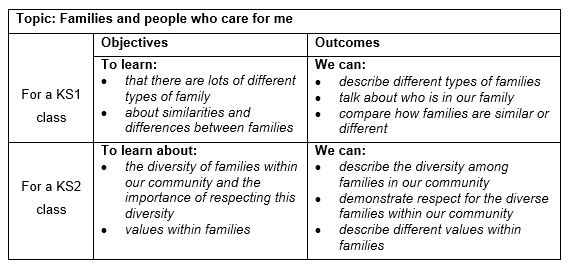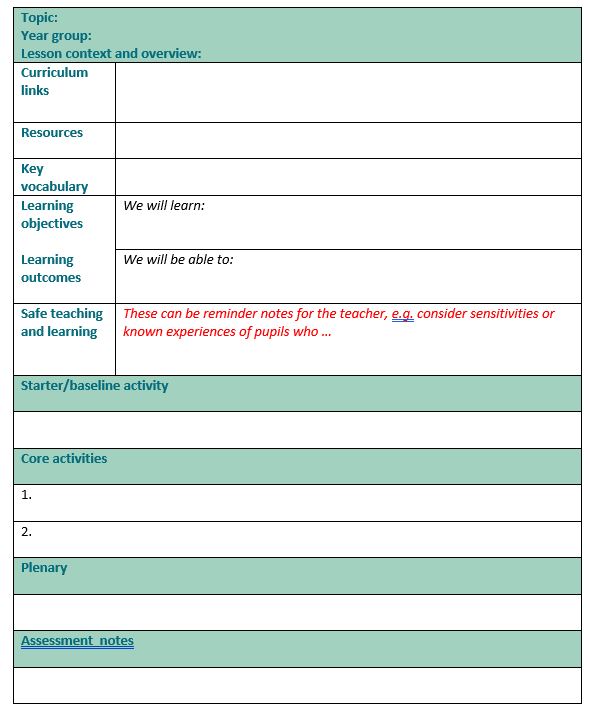Last month’s blog looked at the ‘What’ of developing a PSHE curriculum, outlining the process for creating the long and medium-term planning of a progressive, spiral programme from Y1 to Y6.
This month it is more about the ‘How’ – the content of topics and lesson plans for different year groups. Content and delivery will adapt and change depending on schools’ individual circumstances, but this post highlights some pointers for creating a PSHE lesson which combines controlled, managed discussion with active learning to move pupils on in their learning and understanding.
Creating a PSHE lesson plan
A PSHE lesson plan should have:
Clear overall learning objectives and outcomes for the lesson
Learning objectives are top level and should be linked to topic aims. Learning outcomes are essentially what those objectives look like in practice – they might begin ‘I/We can…’ but need to be measurable, so include active verbs such as ‘identify’; ‘explain’; ‘demonstrate’ rather than ‘know’; ‘understand’; ‘learn’ which are harder to evidence or measure.
Examples of objectives and outcomes:

Safe learning environment
Consideration of a safe learning environment which enables pupils to feel safe, secure and free of judgement when discussing potentially sensitive or issues which are personal to individuals and their lives. Establishing a safe environment will also lead to more engaging lessons and successful learning, and can also impact on behaviour and progress. Ways to do it will be explored in more detail in next month’s blog, but include establishing or revisiting ground rules, a consideration of any potential sensitivities, or pupils who may be vulnerable or affected by particular lesson content, the use of distanced learning materials and the provision of relevant signposting opportunities to additional support.
A baseline activity
This will establish what pupils know already, whether it is the beginning of a topic to help gauge any existing knowledge, where pupils might be coming from, or to highlight any misconceptions, or within a topic to recap on or reinforce previous learning. It can be a valuable way to inform planning, in case there is anything which needs to be revised or re-evaluated. Baseline activities can also be revisited, either at the end of a lesson, a series of lessons or a topic, to demonstrate or evaluate progress.
Examples of baseline activities:
- Draw and write
- Quiz
- Head, heart, hands
- Continuum line
- Explain to an alien
- Mindmapping or spider diagram
- Where do I put myself? (rating one’s knowledge along a scale)
Core activities
These should be active and engaging, and enable learning to be both established and developed. Activities should relate to the learning objectives and enable assessment and evidencing of the learning outcomes. Activity content should also be relevant to pupils’ lives, and any skills taught applicable beyond the classroom. Some examples of activities that can be adapted for different age groups can be found in the Resources section below.
Plenary
A plenary or ‘round-up’ type activity to consolidate learning. This can be as simple as going around a circle and asking pupils to ‘tell me one thing you have learned’. However, it can also be a more formal assessment activity – for learning within a lesson, a series of lessons, or the end of a topic.
Examples of plenary activities include:
- Quiz
- Head, heart, hands
- Tell me one thing … (and variations on this
- A revisit of baseline activities such as Draw and Write; Mindmapping; Continuum and Where do I put myself?
Assessment opportunities
Assessing learning in PSHE does not mean making a judgement about a pupil’s character or behaviour, but about measuring progression in knowledge gained and skills developed and applied. Assessment can take place during learning (assessment for learning) or afterwards (assessment of learning), can be formative or summative (or a combination of both), and identified explicitly or implicitly within a lesson plan. Opportunities for assessment should be built in to activities (discussion with pupils can be a useful way to do this), but also used more formally, especially if a lesson comes at the beginning or end of a topic, or is being used to assess a particular outcome.
An example of a lesson plan template following this format can be found below.
Resources
Exemplar lesson plan template

Ideas for discussion techniques
- Named lolly sticks/straws picked out of a pot etc.
- Coloured pom-poms/balls (can be used as a pairing activity e.g. ‘Find someone with the same/a different coloured ball)
- Smiley faces/thumbs up (used by pupils to indicate what they think about someone’s contribution, or that they want to contribute)
- Pass the object (can also be used as a talk signifier i.e. you can only talk while holding it)
- Throw the ball (used to randomly select a child for feedback; child receiving ball then selects another child to throw it to)
- ‘Find someone who…’ warm-up activity to encourage pupils to move around and talk to someone different (g. ‘Find someone who likes the same sports as you; Find someone who doesn’t have a pet’ etc).
Activities that can be adapted for different topics and age groups
- Card sort – Can work in lots of different ways e.g. matching; sorting ‘yes/no/don’t know/maybe’; how would you respond? etc.
- Carousel – Half the group forms a circle facing outwards. The other half forms another circle facing the first so that each person in the inner circle faces someone in the outer circle. Pairs discuss an issue or dilemma for a minute or so then move one place around the circle to discuss it with someone else for a different opinion.
- Concept Cartoon – An image of a situation where different people’s thoughts and opinions are shown in thought bubbles. Some people have empty thought bubbles – pupils fill in what these might be thinking/feeling.
- Conscience Alley – A choice of behaviour in a situation is given. Pupils stand in a line opposite one another forming an ‘alley’. One pupil walks down the ‘alley’ and each person gives them a different choice and reason for making it. At the end of the alley the pupil says what they have decided to do, and why.
- Continuum line – An imaginary line is drawn down the room. One end of the line represents the extreme of a viewpoint (e.g. ‘Totally agree’) and the other end represents the opposite view. Statements are read out, and pupils stand along the continuum according to what they think. Pupils feed back their reasons for where they are standing, and can change position on the line if others’ feedback changes their mind.
- Corners – Different opinions/statements are given in different corners of the room. Pupils move into a corner depending on which they agree with, or stay in the middle if they’re not sure. Pupils in each corner have to justify their opinion and persuade the ‘don’t knows’ to join them.
- Diamond 9 – Pairs or small groups are given 9 prepared cards, each with a statement relating to an issue for discussion (e.g. the qualities of a good friend). Each group arranges the cards in the shape of a diamond to represent how important they think each statement is in relation to the issue. The activity can also be done with a lower number of cards, or include blank cards given which pupils fill in themselves.
- Dilemmas – In groups, pupils read an account of a situation which poses a dilemma/leaves the person needing to make a choice. Pupils consider the dilemma from different points of view e.g. person involved, friends, wider community etc. and discuss the impact it will have on them all depending on the decision that is made.
- Draw and Write – Pupils are given a topic and are asked to draw and/or write anything around the outside they can think of to do with that topic. They can then revisit their Draw and write at the end of a topic/lesson and add in anything additional that they have learned in a different colour.
- Explain to an alien – ‘Imagine an alien came to earth and you had to explain X to them. What would you say?’
- Graffiti Wall – Pupils write comments/opinions/facts/what they know about a topic onto a large sheet of paper for display. Alternatively, pupils write on post-its which are stuck on a ‘wall’. The wall can be added to as understanding develops.
- Head, heart, hands – Pupils have an outline of a body. In the ‘head’ they write down one thing they would like to know about a topic, in the ‘hands’ one thing they would like to be able to do, and in the ‘heart’ something that they feel about the topic/issue. It can be revisited at the end of teaching for reflection on whether these things have changed/been achieved. Body outlines can be used in other ways e.g. by identifying where on and in the body someone might feel particular emotions; to indicate body parts; to demonstrate requirements for good health.
- Silent conversation/debate – Small groups have a large sheet of paper with a question in the centre. Without talking individuals write their response in silence, then each group moves to another table, reads responses on the sheet there and adds their own. This activity can also be done out loud for groups to contribute ideas together.
- Snowballing/Think, pair, share – Pupils work alone listing ideas related to a question, issue etc. They form pairs and the pairs share views. Pairs create a four and share combined views etc.
Exemplar lesson for Year 1
Thank you very much to Lucy Marcovitch for sharing this third blog in the six part series for us.
Lucy is a writer and educator with over 25 years experience in education. She began her teaching career in Leeds primary schools, then moved into resource writing and development. She spent 10 years as the National Curriculum advisor for PSHE education, which included participating in two National curriculum reviews, and developing the first national guidance, training and assessment resources for the subject. Her consultancy work includes developing and writing classroom resources and guidance materials, and educator training and guidance for a variety of charities and commercial clients including the BBC, Teach First, Hopscotch Consulting and Discovery Education. She is a part-time lecturer on the Childhood, Youth and Education studies BA at Coventry University.






